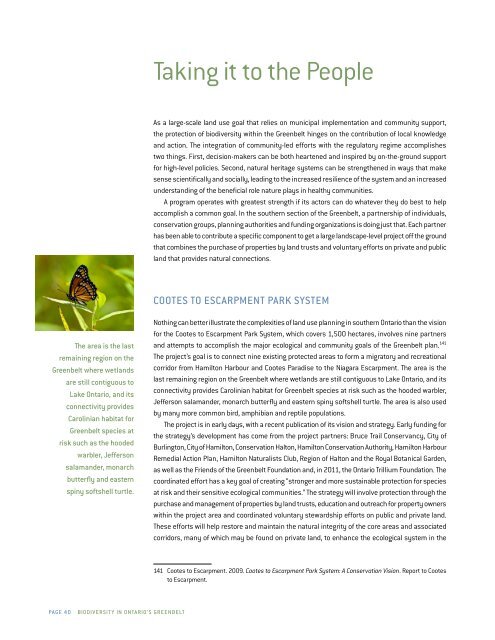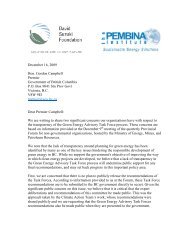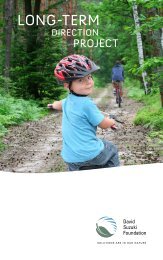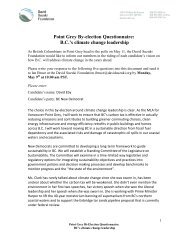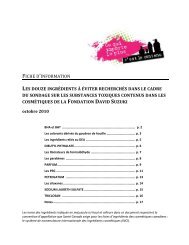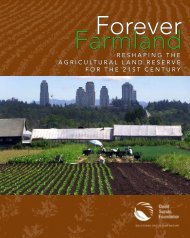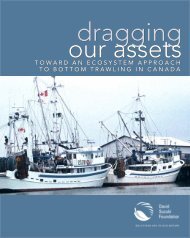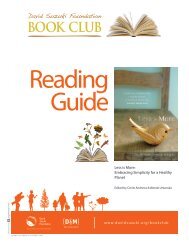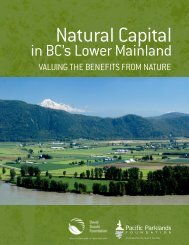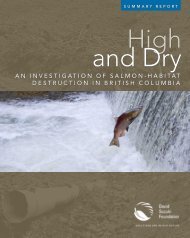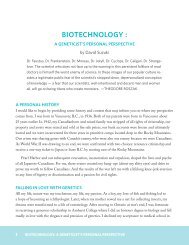Biodiversity in Ontario's Greenbelt (PDF) - David Suzuki Foundation
Biodiversity in Ontario's Greenbelt (PDF) - David Suzuki Foundation
Biodiversity in Ontario's Greenbelt (PDF) - David Suzuki Foundation
You also want an ePaper? Increase the reach of your titles
YUMPU automatically turns print PDFs into web optimized ePapers that Google loves.
Tak<strong>in</strong>g it to the People<br />
As a large-scale land use goal that relies on municipal implementation and community support,<br />
the protection of biodiversity with<strong>in</strong> the <strong>Greenbelt</strong> h<strong>in</strong>ges on the contribution of local knowledge<br />
and action. The <strong>in</strong>tegration of community-led efforts with the regulatory regime accomplishes<br />
two th<strong>in</strong>gs. First, decision-makers can be both heartened and <strong>in</strong>spired by on-the-ground support<br />
for high-level policies. Second, natural heritage systems can be strengthened <strong>in</strong> ways that make<br />
sense scientifically and socially, lead<strong>in</strong>g to the <strong>in</strong>creased resilience of the system and an <strong>in</strong>creased<br />
understand<strong>in</strong>g of the beneficial role nature plays <strong>in</strong> healthy communities.<br />
A program operates with greatest strength if its actors can do whatever they do best to help<br />
accomplish a common goal. In the southern section of the <strong>Greenbelt</strong>, a partnership of <strong>in</strong>dividuals,<br />
conservation groups, plann<strong>in</strong>g authorities and fund<strong>in</strong>g organizations is do<strong>in</strong>g just that. Each partner<br />
has been able to contribute a specific component to get a large landscape-level project off the ground<br />
that comb<strong>in</strong>es the purchase of properties by land trusts and voluntary efforts on private and public<br />
land that provides natural connections.<br />
Cootes to Escarpment Park System<br />
The area is the last<br />
rema<strong>in</strong><strong>in</strong>g region on the<br />
<strong>Greenbelt</strong> where wetlands<br />
are still contiguous to<br />
Lake Ontario, and its<br />
connectivity provides<br />
Carol<strong>in</strong>ian habitat for<br />
<strong>Greenbelt</strong> species at<br />
risk such as the hooded<br />
warbler, Jefferson<br />
salamander, monarch<br />
butterfly and eastern<br />
sp<strong>in</strong>y softshell turtle.<br />
Noth<strong>in</strong>g can better illustrate the complexities of land use plann<strong>in</strong>g <strong>in</strong> southern Ontario than the vision<br />
for the Cootes to Escarpment Park System, which covers 1,500 hectares, <strong>in</strong>volves n<strong>in</strong>e partners<br />
and attempts to accomplish the major ecological and community goals of the <strong>Greenbelt</strong> plan. 141<br />
The project’s goal is to connect n<strong>in</strong>e exist<strong>in</strong>g protected areas to form a migratory and recreational<br />
corridor from Hamilton Harbour and Cootes Paradise to the Niagara Escarpment. The area is the<br />
last rema<strong>in</strong><strong>in</strong>g region on the <strong>Greenbelt</strong> where wetlands are still contiguous to Lake Ontario, and its<br />
connectivity provides Carol<strong>in</strong>ian habitat for <strong>Greenbelt</strong> species at risk such as the hooded warbler,<br />
Jefferson salamander, monarch butterfly and eastern sp<strong>in</strong>y softshell turtle. The area is also used<br />
by many more common bird, amphibian and reptile populations.<br />
The project is <strong>in</strong> early days, with a recent publication of its vision and strategy. Early fund<strong>in</strong>g for<br />
the strategy’s development has come from the project partners: Bruce Trail Conservancy, City of<br />
Burl<strong>in</strong>gton, City of Hamilton, Conservation Halton, Hamilton Conservation Authority, Hamilton Harbour<br />
Remedial Action Plan, Hamilton Naturalists Club, Region of Halton and the Royal Botanical Garden,<br />
as well as the Friends of the <strong>Greenbelt</strong> <strong>Foundation</strong> and, <strong>in</strong> 2011, the Ontario Trillium <strong>Foundation</strong>. The<br />
coord<strong>in</strong>ated effort has a key goal of creat<strong>in</strong>g “stronger and more susta<strong>in</strong>able protection for species<br />
at risk and their sensitive ecological communities.” The strategy will <strong>in</strong>volve protection through the<br />
purchase and management of properties by land trusts, education and outreach for property owners<br />
with<strong>in</strong> the project area and coord<strong>in</strong>ated voluntary stewardship efforts on public and private land.<br />
These efforts will help restore and ma<strong>in</strong>ta<strong>in</strong> the natural <strong>in</strong>tegrity of the core areas and associated<br />
corridors, many of which may be found on private land, to enhance the ecological system <strong>in</strong> the<br />
141 Cootes to Escarpment. 2009. Cootes to Escarpment Park System: A Conservation Vision. Report to Cootes<br />
to Escarpment.<br />
Page 40<br />
<strong>Biodiversity</strong> <strong>in</strong> Ontario’s greenbelt


